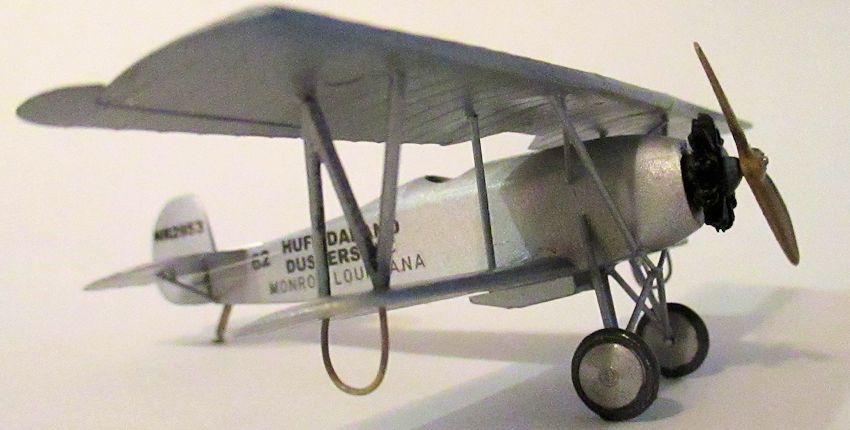
Revell 1/72 Huff-Daland 'Duster'
| KIT #: | H-43 |
| PRICE: | $ |
| DECALS: | home made |
| REVIEWER: | Brian Baker |
| NOTES: | Conversion using Revell Fokker D.VII and other bits |

| HISTORY |
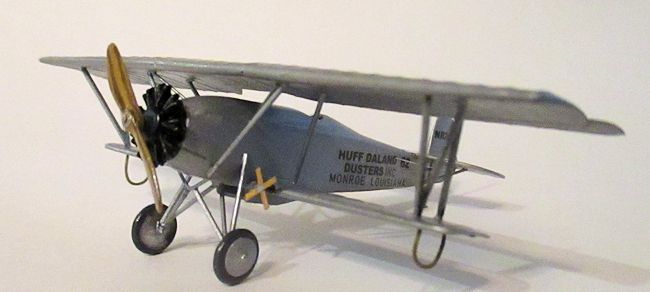 The Huff
Daland Company was formed in Ogdensburg, NY, in 1920, and shortly afterwards,
moved to Bristol, PA.
They produced a series of biplane trainers, light
bombers, and observation types for the U.S. Army and Navy.
Later, the firm became part of the Keystone Corporation,
and later the organization became part of the Loening Company.
Eventually, the firm became part of the Curtiss-Wright
Company.
The Huff
Daland Company was formed in Ogdensburg, NY, in 1920, and shortly afterwards,
moved to Bristol, PA.
They produced a series of biplane trainers, light
bombers, and observation types for the U.S. Army and Navy.
Later, the firm became part of the Keystone Corporation,
and later the organization became part of the Loening Company.
Eventually, the firm became part of the Curtiss-Wright
Company.
In
1924,
the company began producing what was to become the first purpose-built
agricultural aircraft for operations with the Huff Daland Dusters, a firm
created in Macon, GA. It
later operated in Monroe, LA against
the cotton boll weevil infestations common to the area.
Later, the firm became Delta Air Service, and was the
ancestor of Delta Airlines.
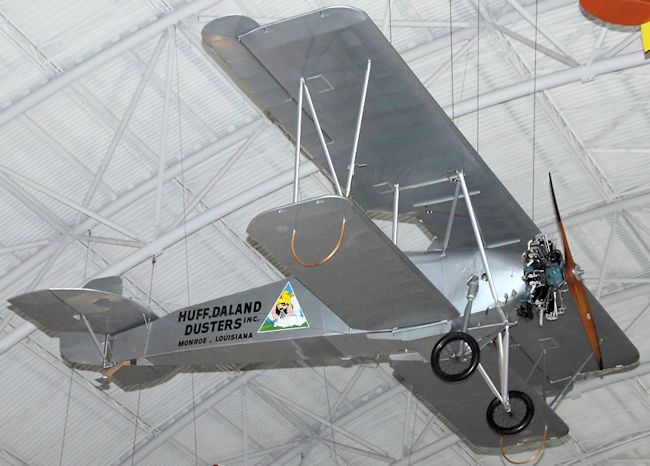 Eighteen
“Dusters” were manufactured by Huff Daland by 1928, and these were operated
until after World War II, when they were replaced by war surplus Stearman
PT-17’s.
Two restored examples currently survive, one at the National Air and
Space Museum, and one at Delta Airlines’ museum in Atlanta.
Eighteen
“Dusters” were manufactured by Huff Daland by 1928, and these were operated
until after World War II, when they were replaced by war surplus Stearman
PT-17’s.
Two restored examples currently survive, one at the National Air and
Space Museum, and one at Delta Airlines’ museum in Atlanta.
The
“Duster” had a wingspan of 33’-3”, a length of 23’-1”, and was powered by a 200
hp. Wright J-4 radial engine.
They were licensed in the “restricted” category, and
carried “NR” registrations, although most photos show them without any
registrations whatsoever, meaning that the photos were probably taken in the
middle twenties when many airplanes were not registered, or just carried state
registrations.
I
saw the restored “Duster” at the NASM’s Silver Hill, MD, storage facility in the
middle 1970’s. It was silver overall with fuselage markings denoting the
company, but no CAA/FAA registration number.
This is how it is now displayed at the Dulles NASM.
| THE KIT |
Since there is no kit of any Huff Daland airplane, I was left to my own
resources.
However, looking sat the airframe,
it is suspiciously like the Fokker D.VII, with only a
few major differences that are mostly minor conversions.
One exception is the ailerons, which on the Fokker are
tapered, while on the Duster, are
constant chord. I ignored this, but otherwise, the model
is accurate.
A new engine and propeller from the spares box was used, and new
tail-feathers were made from card or scrapped model components, but otherwise,
the Revell Fokker D.VII was easily convertible.
| CONSTRUCTION |
I
actually used parts from several D.VII’s that I had scrapped years ago, and made
modifications.
The upper wing required cutting and the addition of a center
section with a squared cutoff, while the lower wings could be used straight from
the box with only a little trimming required for the win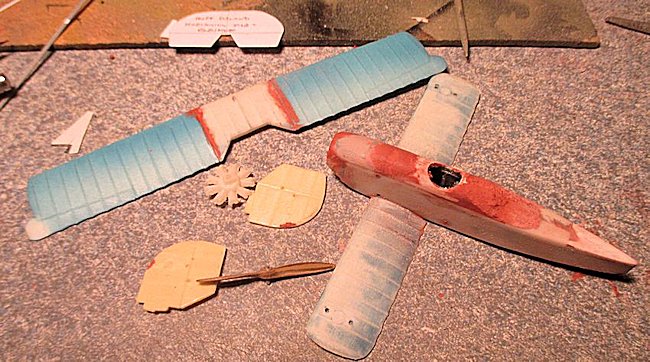 gtips.
I made a three view drawing of the airplane, using the
Duster’s dimensions, and after building up a cockpit interior, I trimmed the
forward section back to conform to the tapered contour of the Duster’s nose
section.
For the cockpit cutout, I used part of the unit from an Olimp Curtiss
Jenny, which provides two different parts. With a little filler, the deed was
done, and the lower wing was attached to the fuselage.
I then cut and mounted the horizontal tail unit, and
whittled out a rudder.
There is no vertical stabilizer,
only a balanced rudder.
A small protrusion underneath the belly serves as the
dust dispenser, which was built up from trimmed card,
and the Revell
landing gear, sans center section, was installed, using some struts from a
previously built Fokker E.III kit.
The N struts from the kit were used without change, but
the cabane struts needed to be modified to conform to the Huff Daland design.
Like the Fokker, there are no rigging wires, and the
only rigging I did was the installation of control cables for the rudder,
elevators, and elevators. The tailskid was scratchbuilt.
gtips.
I made a three view drawing of the airplane, using the
Duster’s dimensions, and after building up a cockpit interior, I trimmed the
forward section back to conform to the tapered contour of the Duster’s nose
section.
For the cockpit cutout, I used part of the unit from an Olimp Curtiss
Jenny, which provides two different parts. With a little filler, the deed was
done, and the lower wing was attached to the fuselage.
I then cut and mounted the horizontal tail unit, and
whittled out a rudder.
There is no vertical stabilizer,
only a balanced rudder.
A small protrusion underneath the belly serves as the
dust dispenser, which was built up from trimmed card,
and the Revell
landing gear, sans center section, was installed, using some struts from a
previously built Fokker E.III kit.
The N struts from the kit were used without change, but
the cabane struts needed to be modified to conform to the Huff Daland design.
Like the Fokker, there are no rigging wires, and the
only rigging I did was the installation of control cables for the rudder,
elevators, and elevators. The tailskid was scratchbuilt.
| COLORS & MARKINGS |
Once
the basic airframe was completed, a coat of aluminum enamel was applied, and
after such parts as the little four bladed dust hopper prop on the leading edge
of the left wing were installed, I made my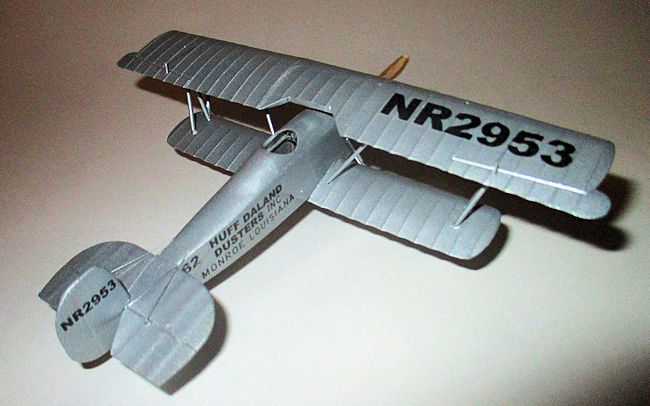 decals.
I used the basic layout of the fuselage markings,
“Huff Daland Dusters, Inc. Monroe, Louisiana” on the
fuselage sides.
I then found a photo of one of these airplanes registered
“NR2953” and applied these to the rudder, lower left wing panel, and upper right
wing panel, as per CAA regulations of the day.
decals.
I used the basic layout of the fuselage markings,
“Huff Daland Dusters, Inc. Monroe, Louisiana” on the
fuselage sides.
I then found a photo of one of these airplanes registered
“NR2953” and applied these to the rudder, lower left wing panel, and upper right
wing panel, as per CAA regulations of the day.
| CONCLUSIONS |
I’ve always liked to build models of airplane that are uncommon, and this model fits in quite well with my collection of agplanes, which includes Stearmans, two FM-2’s,a couple of AT-6’s, a TBM, and even a Westland Lysander. Since this is the original, it is an essential part of the story of ag aviation, and whenever any of the kit manufacturers makes kits of any of the pre-war Waco, Travelair, Bird, Stearman, and other biplane types common in the thirties, I’ll be sure to build some ag conversions. But this one was fun, and there are a lot of conversions of all types of airplanes that can be done from Revell’s Fokker D.VII and E.III kits.
March 2015
If you would like your product reviewed fairly and fairly quickly, please contact the editor or see other details in the Note to Contributors.